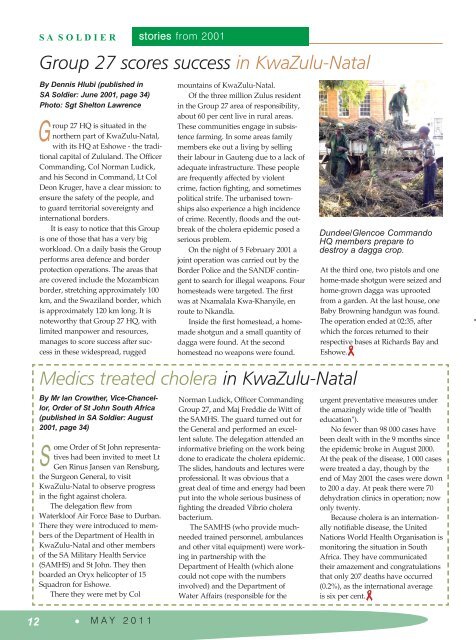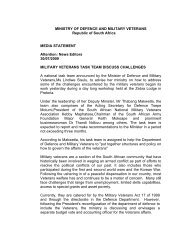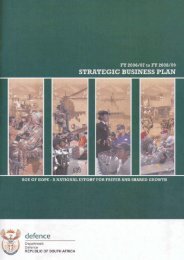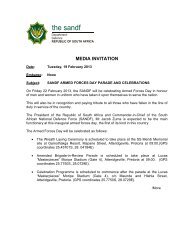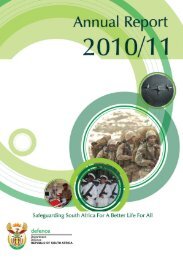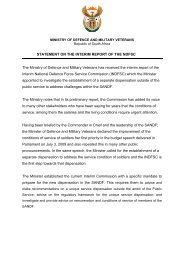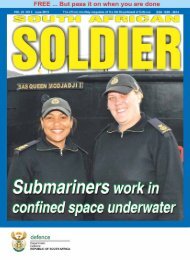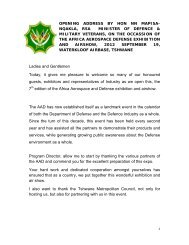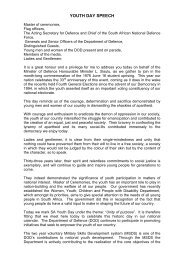letters to the editor - Department of Defence
letters to the editor - Department of Defence
letters to the editor - Department of Defence
Create successful ePaper yourself
Turn your PDF publications into a flip-book with our unique Google optimized e-Paper software.
S A S O L D I E Rs<strong>to</strong>ries from 2001Group 27 scores success in KwaZulu-NatalBy Dennis Hlubi (published inSA Soldier: June 2001, page 34)Pho<strong>to</strong>: Sgt Shel<strong>to</strong>n LawrenceGroup 27 HQ is situated in <strong>the</strong>nor<strong>the</strong>rn part <strong>of</strong> KwaZulu-Natal,with its HQ at Eshowe - <strong>the</strong> traditionalcapital <strong>of</strong> Zululand. The OfficerCommanding, Col Norman Ludick,and his Second in Command, Lt ColDeon Kruger, have a clear mission: <strong>to</strong>ensure <strong>the</strong> safety <strong>of</strong> <strong>the</strong> people, and<strong>to</strong> guard terri<strong>to</strong>rial sovereignty andinternational borders.It is easy <strong>to</strong> notice that this Groupis one <strong>of</strong> those that has a very bigworkload. On a daily basis <strong>the</strong> Groupperforms area defence and borderprotection operations. The areas thatare covered include <strong>the</strong> Mozambicanborder, stretching approximately 100km, and <strong>the</strong> Swaziland border, whichis approximately 120 km long. It isnoteworthy that Group 27 HQ, withlimited manpower and resources,manages <strong>to</strong> score success after successin <strong>the</strong>se widespread, ruggedmountains <strong>of</strong> KwaZulu-Natal.Of <strong>the</strong> three million Zulus residentin <strong>the</strong> Group 27 area <strong>of</strong> responsibility,about 60 per cent live in rural areas.These communities engage in subsistencefarming. In some areas familymembers eke out a living by selling<strong>the</strong>ir labour in Gauteng due <strong>to</strong> a lack <strong>of</strong>adequate infrastructure. These peopleare frequently affected by violentcrime, faction fighting, and sometimespolitical strife. The urbanised <strong>to</strong>wnshipsalso experience a high incidence<strong>of</strong> crime. Recently, floods and <strong>the</strong> outbreak<strong>of</strong> <strong>the</strong> cholera epidemic posed aserious problem.On <strong>the</strong> night <strong>of</strong> 5 February 2001 ajoint operation was carried out by <strong>the</strong>Border Police and <strong>the</strong> SANDF contingent<strong>to</strong> search for illegal weapons. Fourhomesteads were targeted. The firstwas at Nxamalala Kwa-Khanyile, enroute <strong>to</strong> Nkandla.Inside <strong>the</strong> first homestead, a homemadeshotgun and a small quantity <strong>of</strong>dagga were found. At <strong>the</strong> secondhomestead no weapons were found.Medics treated cholera in KwaZulu-NatalBy Mr Ian Crow<strong>the</strong>r, Vice-Chancellor,Order <strong>of</strong> St John South Africa(published in SA Soldier: August2001, page 34)Some Order <strong>of</strong> St John representativeshad been invited <strong>to</strong> meet LtGen Rinus Jansen van Rensburg,<strong>the</strong> Surgeon General, <strong>to</strong> visitKwaZulu-Natal <strong>to</strong> observe progressin <strong>the</strong> fight against cholera.The delegation flew fromWaterklo<strong>of</strong> Air Force Base <strong>to</strong> Durban.There <strong>the</strong>y were introduced <strong>to</strong> members<strong>of</strong> <strong>the</strong> <strong>Department</strong> <strong>of</strong> Health inKwaZulu-Natal and o<strong>the</strong>r members<strong>of</strong> <strong>the</strong> SA Military Health Service(SAMHS) and St John. They <strong>the</strong>nboarded an Oryx helicopter <strong>of</strong> 15Squadron for Eshowe.There <strong>the</strong>y were met by ColNorman Ludick, Officer CommandingGroup 27, and Maj Freddie de Witt <strong>of</strong><strong>the</strong> SAMHS. The guard turned out for<strong>the</strong> General and performed an excellentsalute. The delegation attended aninformative briefing on <strong>the</strong> work beingdone <strong>to</strong> eradicate <strong>the</strong> cholera epidemic.The slides, handouts and lectures werepr<strong>of</strong>essional. It was obvious that agreat deal <strong>of</strong> time and energy had beenput in<strong>to</strong> <strong>the</strong> whole serious business <strong>of</strong>fighting <strong>the</strong> dreaded Vibrio cholerabacterium.The SAMHS (who provide muchneededtrained personnel, ambulancesand o<strong>the</strong>r vital equipment) were workingin partnership with <strong>the</strong><strong>Department</strong> <strong>of</strong> Health (which alonecould not cope with <strong>the</strong> numbersinvolved) and <strong>the</strong> <strong>Department</strong> <strong>of</strong>Water Affairs (responsible for <strong>the</strong>Dundee/Glencoe CommandoHQ members prepare <strong>to</strong>destroy a dagga crop.At <strong>the</strong> third one, two pis<strong>to</strong>ls and onehome-made shotgun were seized andhome-grown dagga was uprootedfrom a garden. At <strong>the</strong> last house, oneBaby Browning handgun was found.The operation ended at 02:35, afterwhich <strong>the</strong> forces returned <strong>to</strong> <strong>the</strong>irrespective bases at Richards Bay andEshowe.urgent preventative measures under<strong>the</strong> amazingly wide title <strong>of</strong> "heal<strong>the</strong>ducation").No fewer than 98 000 cases havebeen dealt with in <strong>the</strong> 9 months since<strong>the</strong> epidemic broke in August 2000.At <strong>the</strong> peak <strong>of</strong> <strong>the</strong> disease, 1 000 caseswere treated a day, though by <strong>the</strong>end <strong>of</strong> May 2001 <strong>the</strong> cases were down<strong>to</strong> 200 a day. At peak <strong>the</strong>re were 70dehydration clinics in operation; nowonly twenty.Because cholera is an internationallynotifiable disease, <strong>the</strong> UnitedNations World Health Organisation ismoni<strong>to</strong>ring <strong>the</strong> situation in SouthAfrica. They have communicated<strong>the</strong>ir amazement and congratulationsthat only 207 deaths have occurred(0.2%), as <strong>the</strong> international averageis six per cent.12• M A Y 2 0 1 1


